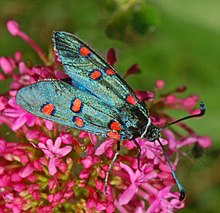|
Zygaena lavandulae
Zygaena lavandulae is a species of moth in the family Zygaenidae. SubspeciesSubspecies include:[1][2]
Distribution This species can be found in Southern France, eastern Spain, Portugal and Italy (only in central and western Liguria),[3] as well as North Africa, including Morocco.[4][5] DescriptionZygaena lavandulae has a wingspan of 31–36 millimetres (1.2–1.4 in) in males and of 35–37 millimetres (1.4–1.5 in) in females. The head is black. The thorax is black with a white collar. Also the abdomen is black, with a slight blue gloss. Forewings are bluish, with five red spots surrounded with black or dark blue. Hindwings are bluish-black with a very large distal red spot. Colorations of the females are rather similar to males, but their forewings are usually bluish-green, with larger spots.[6] HabitatThese moths mainly inhabit rocky places, dry woods and grove rich grasslands.[5] They are present in the Maquis shrubland, characterized by the widespread presence of Cistus species. BiologyThere is one generation per year (univoltine). The larvae feed on Dorycnium pentaphyllum[5] and Anthyllis cytisoides.[7] They develop until April without real dormancy.[5] Adults are on wing from April to June.[5] References
|
||||||||||||||||||||||||||||||||
